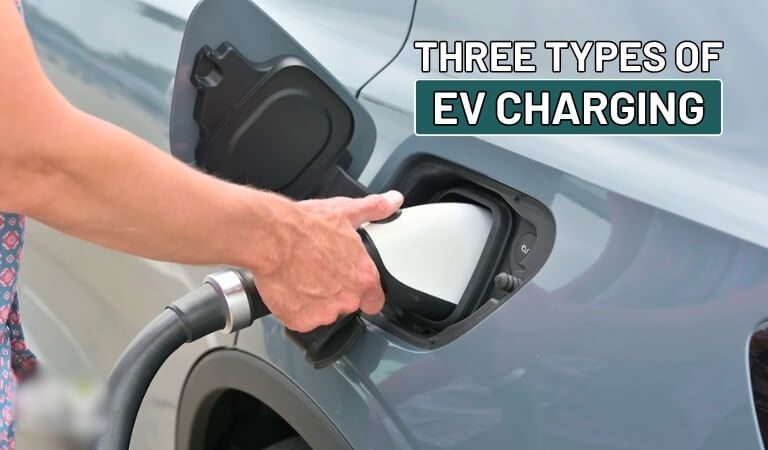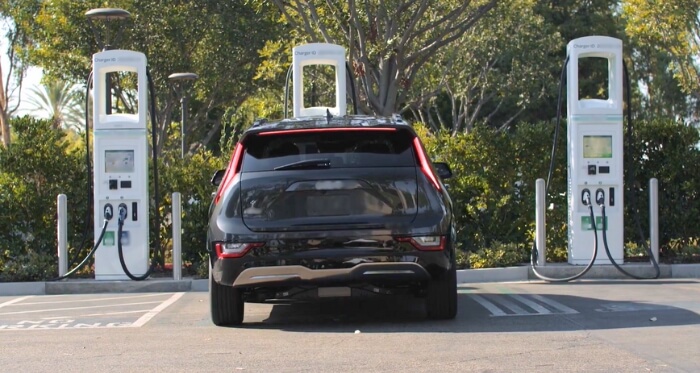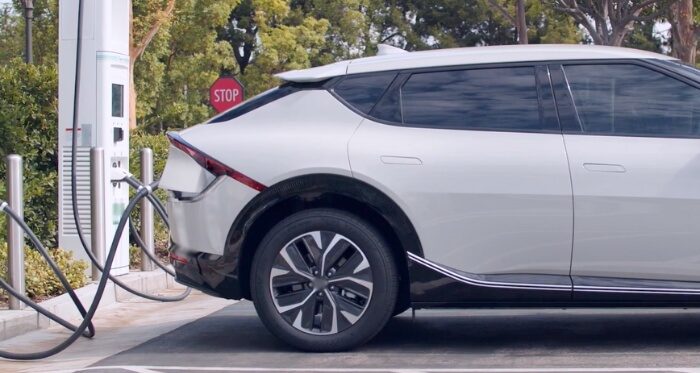All rechargeable electronic devices are charged through the manufacturer’s specific charger. The charger type often varies depending on the specific model of the device and the manufacturer.
The strategy is also similar in the case of an EV, but the only difference is the three various types of chargers. Each charger has a different working capability, and that’s why people mostly ask: What are the three types of EV charging?
Usually, an electric vehicle has three types of charging styles: level 1, level 2, and level 3. Each of the charging processes is different from one another and has different energy-consuming ranges and times. The DC level 3 charging is used for rapid charging, while the level 1 charger is the slowest.
CrackPlatoon Charging Solution LTD is one the best EV charging service providers in Bangladesh. In their services both the AC and the DC charging systems are available.
A detailed explanation of the EV chargers will help you understand how each of them works and which one will be suitable for your EV charging in what situation. Let’s dive deep.
The Basics of EV Charging Procedures
Charging an EV is quite straightforward, much like charging any device you own, but with a bit more power involved. Initially, you need to connect your EV to a charging station using a compatible charging cable.
The power flow from the station to your car is measured in volts (V) and amperes (A). Essentially, volts give the charge its “push” to move it into your vehicle, while amperes measure how much of that electric charge is flowing.
Most home chargers operate at 240 volts, providing a faster charge than a standard 120-volt household outlet. The amperage can vary, but higher amps mean more electricity flows into your EV’s battery, speeding up the charging process.
The car’s onboard charger converts this AC power into DC power, storing it in the battery. Remember, the time it takes to charge depends on your car’s battery size and the charging station’s power output.
So, always ensure you’re using the right type of charger to keep your EV powered up and ready to go!
What Are the Three Types of EV Charging?
The number of EV users is on the rise. People are now more concerned about the climate and are trying their best to use devices that have less impact on the environment. Electric cars are one of the most effective, eco-friendly approaches to a sustainable transportation system. But many people don’t know: What are the three types of EV charging?

These are Level 1, Level 2, and DC Fast Charging, these three types of EV charging serve different purposes and satisfy varying charging requirements.
Level 1 Charging
The most basic form of EV charging is Level 1 charging. It utilizes a standard household outlet with a 120-volt power supply. This method is convenient for charging at home.
This charging type only comes first because it’s the basic one. Also, it is the slowest of the three types. Level 1 charging is suitable for scenarios where overnight charging is feasible, such as residential areas.
The charging time for Level 1 chargers varies, often requiring several hours to fully charge an EV. This method typically provides power in the range of 2 to 5 miles per hour and takes up to 30 hours of charging. It is suitable for daily commuting but less practical for long journeys.
Level 2 Charging
The second charging method is Level 2, which offers a faster and more versatile solution compared to Level 1. It employs a 240-volt power supply equal to 7–19 KW, commonly found in residential charging stations and public charging points.
Furthermore, Level 2 charging is well-suited for various applications, including home charging, workplace charging, and public charging infrastructure. CrackPlatoon has level 2 charging for EV users in Bangladesh. Their model Alak48 and Amiti21 are classified as level 2 chargers. For the EV users in these regions, these models are a suitable solution for charging their EVs.
Charging an EV using Level 2 charging can provide approximately ten to twenty miles of range per hour, and the mileage per hour depends on the specific car and vehicle. This increased charging speed makes Level 2 charging a practical choice for those in need of quicker charging times without the high power demands.
DC Fast Charging (Level 3 Charging)
DC Fast Charging, or Level 3 charging, is the fastest and most powerful charging solution available. It utilizes direct current (DC) and high-power charging stations to rapidly charge an electric car.

This type of charging is primarily intended for use in locations where quick charging is crucial, such as along highways and at public charging stations. Level 3 rapid charging or DC charging significantly reduces EV charging times in comparison to Level 1 and Level 2.
It can provide up to 80% charge in approximately 30 minutes, with a supply power of up to 480 volts, making it ideal for long-distance travel and minimizing charging-related downtime. However, it requires specialized charging equipment and the compatibility of EVs with Level 3 charging.
CrackPlatoon has a level 3 charging model namely Rumi71 DC charger. This has all the requirements to fulfill the need for fast charging solutions for EV users in Bangladesh. The distinctions between Level 1, Level 2, and DC Fast Charging are significant and it is essential to understand for every EV owner to choose the most suitable charging solution based on their needs, travel patterns, and the availability of charging infrastructure.
As the growth of the electric vehicle market continues, advancements in charging technology will likely enhance the efficiency and accessibility of these charging methods.
Charging Infrastructure
Development, availability, and flexibility of EV charging are crucial to any EV and its users. Charging infrastructure can be broadly categorized into two main segments: home charging and public charging.
Home Charging
Essentially, you can charge your electric vehicle at home using what is commonly referred to as Level 1 charging. An Electric Vehicle Supply Equipment (EVSE) cable 1 or connector enables you to charge the car using a 3-pin plug connected to a domestic socket. This cable is typically included with every electric vehicle.
Residential Charging Options
Home charging is the foundation of the EV ownership experience. EV owners typically have the option to install both Level 1 or Level 2 charging stations at home, providing the convenience of overnight charging.

Level 1 charging uses a typical household outlet, while Level 2 charging involves a dedicated charging station with a 240-volt power supply. The CrackPlatoon’s Home EV Charging System, featuring the Amiti21 charging pile, stands out in the realm of home EV charging solutions.
Designed for versatility, it supports AC charging with a robust 7-22kW power output, accommodating Type1, Type2, and GB/T connectors. Its sleek, lightweight design allows for easy installation either as a wall box or floor stand, making it perfect for various settings including offices, shopping malls, charging stations, and family garages.
With an IP54 rating, it promises durability and minimal standby power consumption under 2W. Enhanced with real-time monitoring, remote diagnostics, OTA updates, multiple payment options, and comprehensive electrical protection, it sets a high standard, validated by TUV and CE certifications, for reliable and user-friendly home EV charging.
Importance of Home Charging
For daily EV use, charging at home is the best way, as it ensures the vehicle starts each day with a full or nearly full battery. This charging convenience eliminates the need for frequent visits to publicly charged stations and supports the integration of EVs into the daily routines of users.
Considerations for Installing
EV owners need to consider factors such as the availability of electrical infrastructure, installation costs, and charging speed when deciding on a home charging solution. As the popularity of EVs grows, there is an increasing emphasis on making home charging options accessible and cost-effective.
Public Charging
Apart from the home charging, you have the option to charge your car outside. Most public EV charging stations utilize the level 2 and level 3 stations. These fast and rapid EV chargers are great for emergencies and short-term charging.

Development of Public Charging Networks
Public charging infrastructure plays an essential role in addressing the charging needs of EV users who may not have access to home charging or require fast charging on the go.
Governments, businesses, and private entities are investing in the development of public charging networks to create a comprehensive charging ecosystem. CrackPlatoon, the best EV charging supplier in Bangladesh, introduces advanced DC EV chargers in public areas.
Types of Public Charging Stations
Public charging stations come in various forms, ranging from Level 2 charging points at shopping centers and workplaces to DC Fast Charging stations along highways. The diversity of charging options caters to different charging speeds and use cases, enhancing the overall accessibility of EV charging.
CrackPlatoon’s lineup of public EV charging systems, including the RUMI71 Fast DC, ALAK48 AC, and MIHIRS2 charging piles, showcases a fusion of modern design, efficiency, and user-centric features.
These chargers have a broad range of uses for public spaces such as commercial squares, expressway service areas, bus terminals, offices, shopping malls, and industrial parks. They have versatile installation options (wall box or floor stand), robust power outputs (7-43kW), and compatibility with multiple connector types (Type1, Type2, GB/T).
Their IP54-rated, dustproof, and waterproof builds ensure durability across temperatures. Key offerings include remote diagnostics, OTA updates, multiple payment options, and comprehensive electrical protection, emphasizing ease of use, maintenance efficiency, and wide applicability to various EV models.
Accessibility and Availability
The success of public charging infrastructure hinges on its accessibility and availability. Efforts are being made to deploy charging stations in urban areas, along major highways, and in regions with limited home charging opportunities. Real-time information on charging station availability is also becoming increasingly important for EV users.
To increase the availability of charging stations in various urban places in Bangladesh, CrackPlatoon CSL is on a mission. They have already built quite a lot of EV chargers, and you can navigate through the smartphone application.
Challenges and Future Prospects
Challenges such as charging station compatibility, standardization, and addressing “range anxiety” are being addressed to improve the user experience. The future of public charging infrastructure involves advancements in technology, increased collaboration between stakeholders, and the incorporation of smart charging solutions to optimize charging network efficiency.
You can reach CrackPlatoon EV Charging Station to charge your electric car battery, as all of their charging stations are compatible with a wide range of cars. These chargers are easy to use and provide a quick charge. Ultimately, the goal of the charging stations is to establish optimal convenience for the users.
Furthermore, a well-developed and diverse charging framework is critical for the extensive adoption of electric vehicles. Balancing home charging convenience with the accessibility and efficiency of public charging will play a vital role in modeling the future of EV charging infrastructure.
Final Words
The differences in electrical equipment differ among various EV manufacturers, but the functionality is often similar. For example, some Tesla EVs are made with powerful batteries compared to other EV brands, but they also require charging, and the charging process is similar to others.
However, many people are confusion related to the EV charging processes and often ask: What are the three types of EV charging? Generally, there are three types of EV charging: Level 1, Level 2, and DC Rapid Charging.
The Level 1 charging method is the basic one, and all EV cars are designed to charge the battery from home through this process. Level 2 is faster than the first one, but it is also an AC method and requires a dedicated circuit.
The DC is the fastest EV charging method among the rest, and it takes minutes rather than hours to fully charge an electric car. Different EVs have various capabilities, so it is advisable to choose an appropriate Level 2 fast charger and DC rapid charger for the car. Undoubtedly, CrackPlatoon will be the best choice for you.
